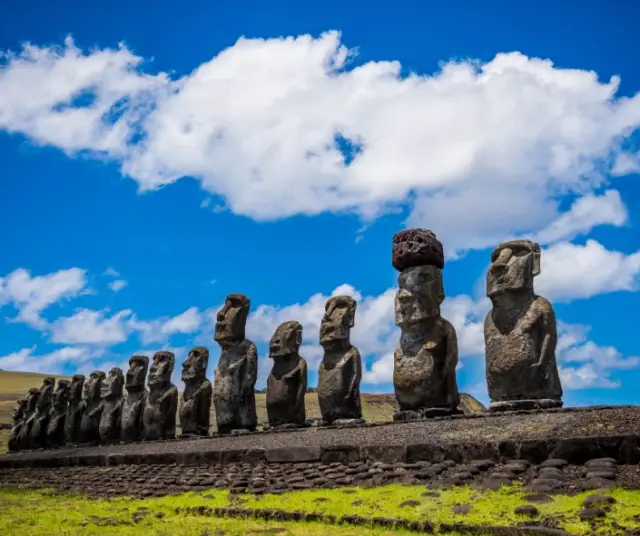Easter Island , known as Isla de Pascua, is a remote and mysterious tourist destination located in the Pacific Ocean . It belongs to Chile and is famous throughout the world for its enigmatic monolithic statues, the moai. This small island is a fascinating and unique place for travelers seeking to discover an ancient culture, breathtaking landscapes, and rich history.
Easter Island History and Culture
Easter Island has an intriguing history that goes back centuries. The first inhabitants, belonging to the Rapa Nui culture, arrived on the island around 700 AD and developed a unique and highly organized society. They built gigantic stone statues, the famous moai, which still dominate the island today.
The reason for the construction of the moai remains largely a mystery. Some theories suggest that these statues represented important ancestors, tribal leaders, or gods, and that their erection was meant to protect the island. Other hypotheses speak of rivalry between clans, since each group carved its own statue to demonstrate power and prestige.
As natural resources were depleted and civil wars ravaged the island, the Rapa Nui culture began to decline. The arrival of Europeans in the 18th century made the situation even worse. Rapa Nui's population was drastically reduced due to diseases brought by the colonizers and slavery. However, over the years, the descendants of the ancient Rapa Nui have worked hard to preserve and revitalize their culture and traditions.
The Mysterious Moai of Easter Island
The moai are the hallmark of Easter Island and attract visitors from all over the world. These majestic monolithic statues carved from volcanic tuff can reach heights of up to 10 meters and weigh several tons. It is estimated that they were carved and erected between the 10th and 16th centuries.
The way in which the ancient Rapa Nui managed to transport and lift these huge statues has been the subject of debate among experts. It is believed that the moai were carved in quarries located on the side of a volcano and then moved to their final locations using systems of rollers and ropes. Additionally, many moai had a stone structure called a " pukao " on top, which is believed to have represented ceremonial hats.
One of the most impressive places to observe the moai is the Rano Raraku quarry, where there are hundreds of statues in different stages of carving and transportation. Another outstanding place is Ahu Tongariki, with 15 aligned moai, the largest group on the island. Each moai has its own character and expression, which makes them unique and fascinating.
Easter Island Legends and Myths
Easter Island is steeped in legends and myths that have been passed down from generation to generation. One of the best known legends is that of the origin of the moai. According to Rapa Nui oral tradition, the moai were carved with the help of gods called " kupua " and some moai are believed to have walked from the quarry to their final locations. This legend contributes to the mystique and aura of mystery that surrounds the statues.
Another famous legend is that of Hotu Matu a, the king who led the first settlers to the island from a distant land called "Hiva". The story of their arrival in canoes and settlement on Easter Island is an essential part of Rapa Nui history and has been preserved through traditional song and dance.
Easter Island Conservation and Preservation
Given the cultural and archaeological importance of the moai and other sites on the island, Easter Island has been declared a UNESCO World Heritage Site in 1995. This designation has helped protect and conserve the island's valuable cultural and natural resources.
The conservation of the moai and archaeological sites is a constant challenge due to erosion, weather and tourism. Efforts to preserve the moai include measures such as stabilization of the soil around the statues, restoration of damaged moai, and education on the importance of respecting sacred sites.
Additionally, the Rapa Nui community plays a vital role in preserving their cultural heritage. The island's inhabitants have worked to revitalize their language and traditions, while promoting sustainable and environmentally friendly tourism.
Easter Island Tourism
Tourism has increased on Easter Island in recent decades, boosting the local economy but also posing challenges to the balance between development and cultural and environmental preservation. The island receives visitors from all over the world who come to marvel at the moai, learn about the Rapa Nui culture, and enjoy the natural beauty of the place.
One of the most popular activities on Easter Island is touring the different archaeological sites and learning about the history and meaning of the moai. In addition, you can enjoy beautiful beaches, go hiking on volcanoes, participate in traditional ceremonies and try delicious local food.
It is important to mention that due to its remote location, traveling to Easter Island may require careful planning, as flights from mainland Chile are limited and can be expensive. So, if you are looking for a trip full of mystery, culture and natural beauty, look no further than Easter Island in Chile. A unique and transformative experience awaits you that will take you on a journey through time and history.
Get ready to discover the hidden secrets of Easter Island and contemplate the serene gaze of the moai as you immerse yourself in the enchantment of this remote wonder in the middle of the vast Pacific !
